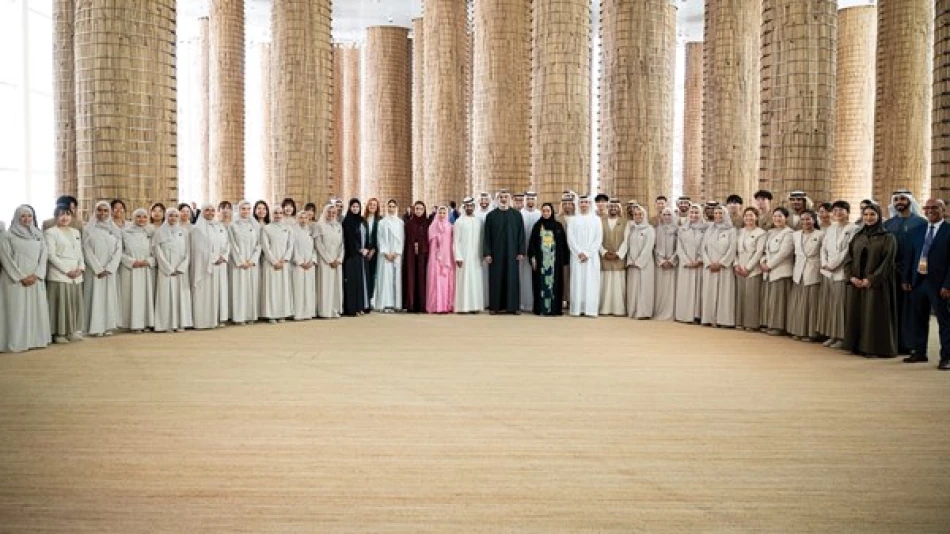
Abu Dhabi Crown Prince Visits UAE Pavilion at Expo 2025 Osaka, Showcasing Emirati Innovation and Vision
UAE Crown Prince Showcases Innovation Legacy at Expo 2025 Osaka, Marking 55 Years of Japan Partnership
Abu Dhabi Crown Prince Sheikh Khaled bin Mohamed bin Zayed Al Nahyan's visit to the UAE pavilion at Expo 2025 Osaka underscores a strategic diplomatic milestone: the Emirates' return to Japan's world stage after more than five decades. The pavilion's innovative design and sustainability focus signal the UAE's intent to position itself as a bridge between tradition and cutting-edge technology on the global stage.
Architectural Innovation Meets Cultural Heritage
The UAE pavilion stands as a testament to sustainable innovation, featuring 90 columns rising 16 meters high, crafted from over two million recycled palm fronds. This palm tree-inspired design goes beyond aesthetics—it represents the UAE's commitment to circular economy principles while honoring its Bedouin heritage.
The architectural choice reflects a broader trend among Gulf nations to showcase environmental responsibility at international forums. Unlike traditional pavilions that rely heavily on imported materials, the UAE's approach demonstrates how emerging economies can lead in sustainable construction practices.
Strategic Positioning in Global Innovation Race
The pavilion's thematic zones highlight the UAE's diversification strategy beyond oil dependency. Sections dedicated to space exploration, healthcare innovation, and sustainable technology showcase the country's investments in future-oriented sectors—a clear message to international investors and partners about the Emirates' long-term economic vision.
Diplomatic Significance of the 55-Year Return
The Crown Prince emphasized the symbolic importance of returning to Osaka after the UAE's first participation in 1970. This timeline coincides with the UAE's formation as a federation in 1971, making the Expo participation both a celebration of national achievement and a diplomatic reset with Japan.
The timing is particularly strategic. As global supply chains shift and countries seek alternatives to traditional partnerships, the UAE-Japan relationship offers both nations opportunities in energy transition, technology transfer, and regional stability. Japan's expertise in advanced manufacturing complements the UAE's position as a Middle Eastern hub for innovation and logistics.
Youth Diplomacy as Soft Power Tool
The deployment of 46 young ambassadors, including 24 Emiratis, to guide visitors represents a calculated soft power strategy. This approach mirrors successful cultural diplomacy programs by South Korea and Singapore, where young representatives create lasting impressions on international visitors while building future diplomatic networks.
Market Implications and Investment Signals
For investors tracking Middle Eastern markets, the pavilion's focus areas reveal priority sectors for UAE government spending and policy support. The emphasis on healthcare technology and sustainable innovation suggests continued fiscal backing for these industries, potentially creating opportunities for international partnerships and joint ventures.
The high-level delegation accompanying the Crown Prince—including key ministers and the Japan special envoy—indicates that commercial agreements and investment memorandums likely accompanied this ceremonial visit. Such diplomatic missions typically generate follow-up business delegations and sector-specific partnerships.
Regional Competition and Global Positioning
The UAE's sophisticated pavilion approach contrasts with more traditional national presentations at international expos. While neighboring Saudi Arabia focuses heavily on NEOM and Vision 2030 messaging, the UAE's "From Earth to Ether" theme suggests a more nuanced narrative about technological evolution rooted in cultural authenticity.
This positioning becomes crucial as Gulf states compete for foreign investment and international partnerships in the post-oil transition era. The UAE's strategy appears focused on demonstrating practical innovation rather than futuristic promises, potentially appealing to risk-averse international partners and investors.
Long-term Strategic Outlook
The six-month Expo timeline through October 2025 provides the UAE with an extended platform to engage with Japan's business community and the 158 participating nations. Given Japan's aging population and the UAE's young demographic, partnerships in robotics, healthcare technology, and sustainable urban development seem natural outcomes.
The cultural programming and ongoing activities suggest the UAE views this participation as a long-term relationship-building exercise rather than a one-time promotional event, indicating sustained diplomatic and commercial engagement with Japan beyond the Expo period.
Most Viewed News

 Layla Al Mansoori
Layla Al Mansoori






